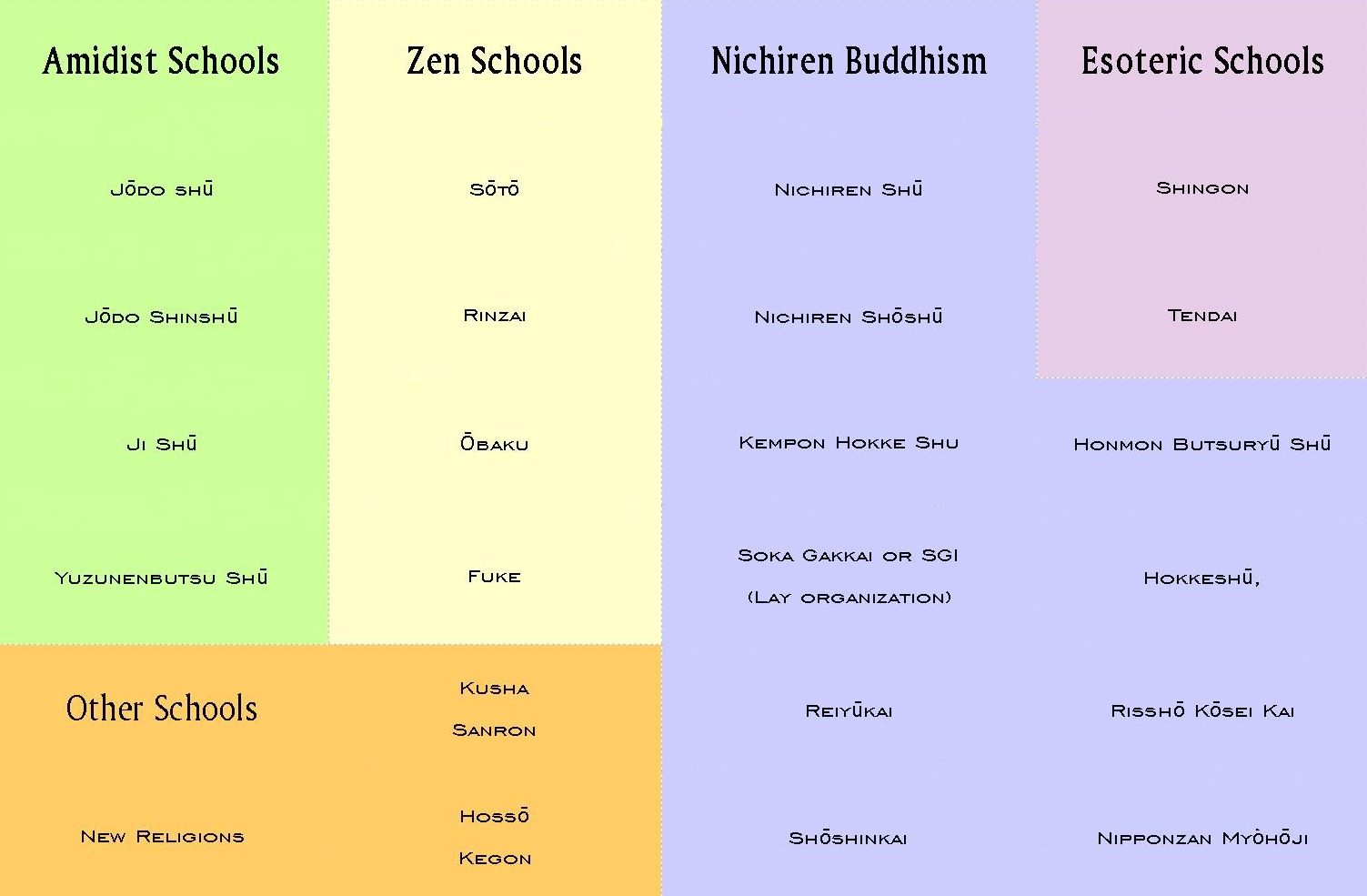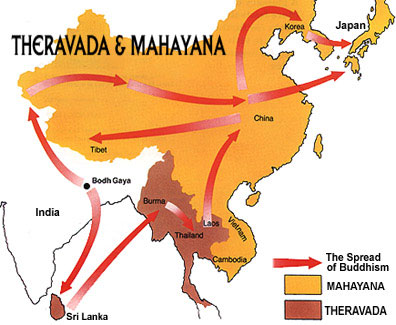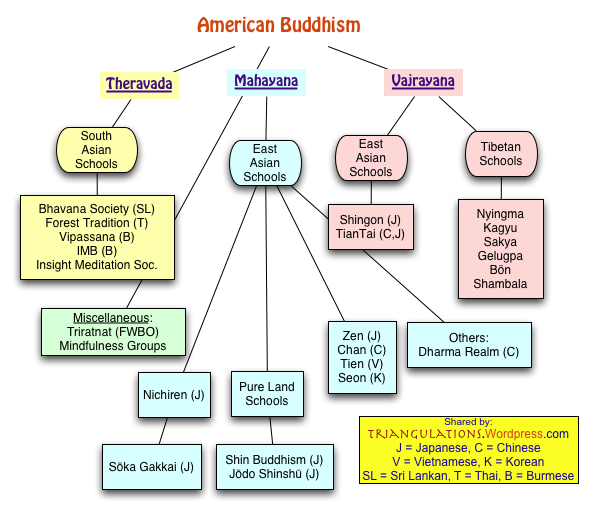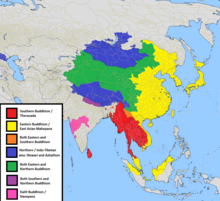Schools of Buddhism
Buddhism has produced during its 2500 -year history, numerous schools and systems. The terms "school" ( vada ), " vehicle " ( yana ) [ via the current of suffering ] or "way" are roughly comparable with the terms "direction", " denomination ", " denomination " or " sect ", where the word "sect" adheres no negative rating and all of these terms have the same meaning.
- 3.1 Madhyamaka
- 3.2 Vijñanavada ( Yogacara )
- 3.3 Pure Land Amidism ( Amitabha Buddhism, faith school)
- 3.4 Saddharmapundarika ( Lotus School )
- 3.5 Vajrayana ( Esoteric Buddhism / Tantrayana / Mantrayana )
- 3.6 Chan / Zen / Son / Thien (meditation school)
Main directions
Essentially, there are two large main directions: the Theravada, the " school of the elders " and the Mahayana, the " Great Vehicle ". The term Hinayana " Light vehicle " as it is often used in Mahayana for the early Buddhism and equated with the Theravada, is in the Theravada itself unknown and will not be accepted, since it represents an obvious devaluation (" hina " literally means not » small " - as usually claimed - but" bad "," common ", " inferior " ). In addition, the early schools that are meant in Mahayana ( Vaibhasika and Sautrantika, sub-sects of Sarvastivada ) have long been extinct. Today Theravada has never heard about these law schools and also represents the views of others.
Of the two large main directions of the Theravada is the older, while the Mahayana has ( 100 BC to 600 AD) emerged only after the turn of the Christian era. The third large main direction is towards the Vajrayana or Tantrayana, which is, however, in spite of specific characteristics attributed to the Mahayana philosophical. The Vajrayana has emerged in India in the period from 400 to 1000 AD and was the resurgent Hinduism (especially Tantrism ) influences.
In contrast to the Theravada, Mahayana is no real and consistent tradition of teaching and practice. The numerous schools not based - as in Theravada - where in the centuries after the Buddha's death set at three councils canon of discourses of the Buddha in Pali language ( the Pali canon, also Tipitaka ), but on a residual stock of parallel emerging and later into Chinese or Tibetan translated, original mostly lost Sanskrit sutras, and a variety later incurred and of itself existing Mahayana sutras ( in Sanskrit). However, these were only selectively recognized by the different schools and made for their own basis. There are thus no common Mahayana canon, but rather Chinese ( San ts'ang ) and Tibetan Collections ( Kanjur ) of different, translated from the Sanskrit texts, plus own Chinese or Tibetan texts.
All sects of Buddhism follow the "Four Noble Truths " Buddhas of suffering, its origin, its overcoming and leading to overcome suffering " Eightfold Path ", which leads to suffering salvation ( liberation from the shackles of illusion and attachment ). This exemption is suffering Nibbana (P.) or Nirvana ( Skr. ) called (" extinction " of greed, hatred and delusion ), which is the common goal of salvation to all denominations. The in the realization of Nirvana, thus attaining Buddhahood ( Buddhata ) existing objective is thus the same everywhere, differing only are the paths that lead to this goal.
The following list does not name all the schools, sects or systems of thought that have emerged in the course of the long history of Buddhism. Listed are only the most important, were in the past or present of great importance or are.
Systems of Hinayana
Theravada ( doctrine of the elders )
- Created: 4th century BC in India.
- Founder: No central founding figure.
- Taxonomists: Buddhadatta (4th / 5th centuries ), Buddhaghosa (5th century ), Dhammapala (5th century ), Anuruddha (12th century)
- Branches: -
- Today's Distribution: Sri Lanka, Myanmar ( Burma ), Bangladesh, Thailand, Laos, Cambodia, Vietnam, China ( Yunnan ), Western world.
- Main sources: Tipitaka ( three baskets ), or Pali canon; Visuddhimagga, Milindapañha, Abhidhammatthasangaha.
- Way of salvation: overcoming of suffering by eliminating the causes of suffering greed, hatred and delusion means of virtue, meditation and knowledge.
Extinct systems
- Mahasanghika. Founded in the 4th century BC Vorbereiterin of Mahayana, in which it was merged.
- Pudgalavada. Founded in the 3rd century BC One of the great early Buddhist schools. Downfall in the 7th century
- Sarvastivada. Founded in the 3rd century BC early Buddhist school with great potency. Walked among the Islamic conquest of India.
- Sautrantika. Founded in the 2nd century AD, early Buddhist school, which provided many impulses to the emergence of the Mahayana with their teachings.
Systems of Mahayana
Madhyamaka
- Formation: the 2nd century AD in India.
- Founder: Nagarjuna (2nd century AD).
- Taxonomists: Aryadeva (3rd century ), Buddhapalita (5th / 6th century), Bhavaviveka (6th / 7th century), Candrakirti (7th century ), Shantideva ( 7 / 8th century ).
- Branches: (1) in China: sanlun; ( 2) in Japan: Sanron.
- Today's Distribution: As an independent school no longer exists, but strong penetration mainly of Tibetan and Sino- Japanese Buddhism.
- Main sources: Prajñaparamitasutra, Mulamadhyamakakarika.
- Way of salvation: knowledge of emptiness ( shunyata ) of all phenomena of existence and realize that this emptiness is the absolute = Erlöstheit.
Vijñanavada ( Yogacara )
- Created: 3 / 4 Century AD in India.
- Founder: Maitreyanatha (3rd / 4th century).
- Taxonomists: Asanga and Vasubandhu (4th century ), Dignaga (5th / 6th century), Dharmakirti (7th century ).
- Branches: (1) in China: Faxiang - zong; ( 2) in Japan: Hosso shu.
- Today's Distribution: As an independent school no longer exists, but strong penetration mainly of Tibetan and Sino- Japanese Buddhism.
- Main sources: Yogacarabhumishastra, Samdhinirmocana, Avatsamsaka, Lankavatara.
- Way of salvation: Knowing that all "only Spirit" ( Cittamatra ) and turning back to the Pure Spirit, the basic awareness = Absolute = salvation.
Pure Land Amidism ( Amitabha Buddhism, faith school)
- Created: 1st century AD in India.
- Founder: -
- Taxonomists: (1) in China Huiyuan ( 334-416 ), Tanluan ( 476-542 ); Daochuo (Japanese Doshaku ) ( 562-645 ) Shandao (Japanese Zendo ) ( 613-681 ) (2) in Japan: Honen Shonin ( 1133-1212 ) and Shinran Shonin ( 1173-1263 ).
- Branches: (1) in China: Jìngtǔ - Zong; ( 2) in Japan: Jōdo shū, Jōdo Shinshu.
- Today's Distribution: China, Japan, Taiwan, Korea, Vietnam, Singapore.
- Main sources: The Great Amitabha Sutra ( Sukhavativyuha - mahâyânasûtra, Japanese Muryôju - kyo ), the Amitabha Sutra Small ( Sukhâvatîvyûhonâma - mahâyânasûtra, Japanese Amida - kyo ) and the so-called Meditation Sutra ( Amitâyurdhyâna - sûtra, Japanese Kanmuryôju - kyô )
- Way of salvation: (1) trust in the helping support of the transcendent Buddha Amitabha ( Amida ); (2 ) Discharge of karma by helping to support effective healing Bodhisattvas; ( 3) rebirth in a Between Paradise ( Sukhavati ); ( 4) Even a Bodhisattva be.
Saddharmapundarika ( Lotus School )
- Genesis: the 3rd century AD in India.
- Founder: ( 1) in China: Zhiyi ( 538-597 ); ( 2) in Japan: Dengyo Daishi Saicho ( 767-822 ).
- Taxonomists: -
- Branches: (1) in China Tiantai zong; ( 2) in Japan: Tendai shū, Nichiren Buddhism
- Current distribution: (1) China: Tiantai zong; (2 ) Japan: Tendai shū, Nichiren schools: Nichiren - Shuu ( 1251 ), Nichiren Shoshu - ( 1290 ), Reiyukai, (1919), Soka Gakkai (1930 ), Rissho Koseikai, (1938 ), Nipponzan - Myohoji (1947 ).
- Main sources: Saddharmapundarikasutra ( Lotus Sutra ).
- Way of salvation: Adoration of the Lotus Sutra, realization of one's own Buddha - nature through practicing of daimoku.
Vajrayana ( Esoteric Buddhism / Tantrayana / Mantrayana )
- Genesis: originated from the 3rd century in India, there are similarities to the Indian Tantrism
- Founder: No central founding figure. ( 1) in Tibet: Padmasambhava (8th century ) [representatives of Vajrayana ]; ( 2) in Japan: Kobo Daishi [ Kukai ] ( 774-835 ) [representatives of the Shingon -shu ].
- Taxonomists: In Tibet, Atisha (982-1054), Marpa (1012-1098), Tsongkhapa ( 1357-1419 ).
- Branches: (1) in China: Zhenyan Mizong; ( 2) in Japan: Shingon; ( 3) in Tibet: Nyingma, Kadampa, Kagyu, Sakya, Gelug
- Today's Distribution: Tibet, Sikkim, Bhutan, Mongolia, Buryatia, Kalmykia, Ladakh, China, Korea, Japan, Western world.
- Main sources: Tantric literature.
- Way of salvation: salvation through experience of the All- identity and development of the Absolute within themselves by secret psychoactive techniques.
Chan / Zen / Son / Thien (meditation school)
- Created: 6th century AD in China, Henan, Songshan, the Shaolin Monastery.
- Founder: Bodhidharma (6th century ).
- Taxonomists: (1) in China: Huineng ( 638-713 ), Shenhui ( 670-762 ), Dongshan Liangjie ( 807-869 ), Caoshan Benji ( 840-901 ), Huangbo Xiyun (Japanese Obaku Kiun ), (d. 850), Linji Yixuan ( jap. Rinzai Gigen ) ( 815-867 ); ( 2) in Japan: Eisai, Rinzai Shuu ( 1141-1215 ), Dogen Soto Shuu ( 1200-1253 ), Ingen Longqi (Japanese Ingen Ryuki ) Obaku Shuu ( 1592-1673 ).
- Branches: (1) in China: Chan - zong [ Huangbo, Linji, Dongshan and Caoshan of the Caodong zong, ]; ( 2) in Japan: Zen -shu ( Rinzai, Soto and Obaku Zen).
- Today's Distribution: China, Taiwan, Japan ( Zen), Korea ( Son), Vietnam ( Thien ), Western world.
- Main sources: Prajñaparamitasutras: Heart Sutra and Diamond Sutra, Lotus Sutra, Lankavatarasutra, koan collections.
- Way of salvation: knowledge ( training the mind ) through meditation and koan.










